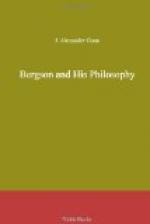The problem at issue between Realists and Idealists turns on the fact that there are two systems of images in existence. “Here is a system of images which I term ‘my perception of the universe,’ and which may be entirely altered by a very slight change in the privileged image—my body. This image occupies the centre. By it all the others are conditioned; at each of its movements everything changes as though by a turn of a kaleidoscope. Here, on the other hand, are the same images, but referred each one to itself, influencing each other no doubt, but in such a manner that the effect is always in proportion to the cause; this is what I term the ‘universe.’"[Footnote: Matter and Memory, p. 12 (Fr. p. 10).] The question is, “How is it that the same images can belong at the same time to two different systems—the one in which each image varies for itself and in the well-defined measure that it is patient of the real action of surrounding images—the other in which all change for a single image and in the varying measure that they reflect the eventual action of this privileged image?"[Footnote: Matter and Memory, p. 13 (Fr. p. 11).] We may style one the system of science, the other the system of consciousness. Now, Realism and Idealism are both incapable of explaining why there are two such systems at all. Subjective Idealism derives the system of science from that of consciousness, while materialistic Realism derives the system of consciousness from that of science. They have, however, this common meeting-place, that they both regard Perception as speculative in character—for each of them “to perceive” is to “know.” Now this is just the




